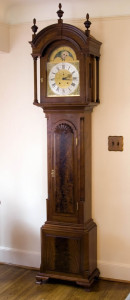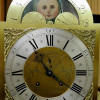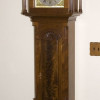- Clocks
- John Townsend Tall Case Clock
John Townsend Tall Case Clock
ES
Ed Stuckey
Updated
1033 0 4 0
Member Gallery
Maker Name
Stuckey, Ed
Accession Number
2018.083
Period
Federal
Materials
Walnut
Year Made
2005
Address
Street
18466 Parkside
City
Detroit
State
MI
Zip
48221
Country
USA
Contact
Email
This clock was reproduced from Albert Sacks book; The New Fine Points of Furniture, page 135. Although the original was made from mahogany, I made mine using Walnut with the secondary wood pine. Mike Siemsen of the Green Lake Clock Company was a great help in providing diagrams of all the molding profiles plus other invaluable help. I ordered the dial and clock movement from Mike. The dial is a copulation of several dials from the book Brass Dial Clocks by Brian Loomes. The dial is brass, which was engraved by John Skeavington of Goodacre Engraving, Loughborough, England. The moon dial was hand painted by Kathi Edwards.
All of the brasses and locks were from Ball and Ball. I made my own hood hinges since the commercial ones were not the right size. I had the walnut lumber cut by a friend and the dried it myself. The walnut crotch for the door was ordered from Pennsylvania. The crotch panel on the pedestal is veneered.
The clock was first stained using very diluted golden brown walnut aniline dye. Usually I do not stain walnut, but I needed to even out the differences in the tonality of the walnut. I then applied one coat of Minwax Antiquing Oil to give depth to the subsequent application of 9 coats of blonde dewaxed shellac. The final rubout was with 600, 1000, and 1200 silicone carbide paper and mineral oil. I then rubbed the clock out with rottenstone and mineral oil and finally 0000 steel wool and paste wax.
The clock was first designed using a 3D Solid Modeling CAD program. That enabled me to generate full-scale drawings.
All of the brasses and locks were from Ball and Ball. I made my own hood hinges since the commercial ones were not the right size. I had the walnut lumber cut by a friend and the dried it myself. The walnut crotch for the door was ordered from Pennsylvania. The crotch panel on the pedestal is veneered.
The clock was first stained using very diluted golden brown walnut aniline dye. Usually I do not stain walnut, but I needed to even out the differences in the tonality of the walnut. I then applied one coat of Minwax Antiquing Oil to give depth to the subsequent application of 9 coats of blonde dewaxed shellac. The final rubout was with 600, 1000, and 1200 silicone carbide paper and mineral oil. I then rubbed the clock out with rottenstone and mineral oil and finally 0000 steel wool and paste wax.
The clock was first designed using a 3D Solid Modeling CAD program. That enabled me to generate full-scale drawings.




